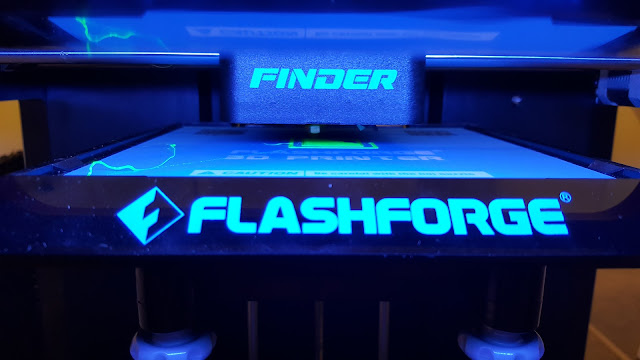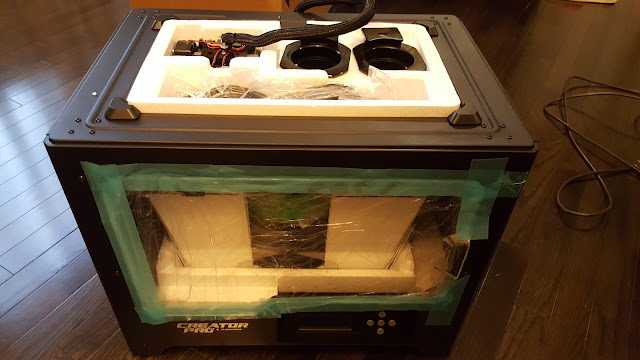30 Days with the Flashforge Finder
340 hours of use, 1096 meters of filament used, 150+ projects printed

Hard to believe 30 days ago I walked out of
Digitmakers in Richmond Hill, Ontario, Canada with my first 3D printer. Actually it was 2 of them. I'll explain why I have to 2 later but for now I can say that it certainly accelerated my learning as I had at least one on me at work and at home.
My background and goals: To understand my angle on how I evaluated this printer, my experience with 3D printing is with using the industrial quality uPrint Plus for about 3 years but zero experience with consumer level 3D printers. I have some cad modelling experience as a mechanical engineer and my goal is to build a 3D printing hub that schools can use. So I am looking for an ok consumer level printer that is portable, relatively cheap (so I can buy multiples) and easy to maintain. There isn't a lot of in-depth talk about the Flashforge Finder online so I hope this will provide you with lots of information to help you make an informed choice of what printer might work best for you.

To this date I can say that every single challenge I had with the Finder I was able to remedy. I printed a lot of stuff and had many failures, but I saw that as all part of the learning process in getting into 3D printing. It's all here on the blog to give you an honest look at what happened when someone new to 3D printing at home chose the Finder to work with.
1. The Good
- The printer is fairly portable as I have been bringing them back and forth from work most of the week days. The built in filament caddy helps a lot with this and so does the cube shaped body design.
- Comes with all tools you may need to maintain or fix it
- Comes with an easy to use slicer program - FlashPrint
- USB file loading works great with good menu control (and it comes with a usb stick)
- The Flashprint software is a pretty versatile program where you can duplicate and cut models
- Flashprint has an advanced mode where you can tweak speeds, temperatures, motor power and almost anything I can think of with the printer's abilities.
- The Finder has calibration features from the LCD menu
- Bed leveling assist is great for beginners but you can learn to do without it
- Not too loud when operating
- Plays a song when the print is finished
- Print area well lit with LED light panels
- The removable build plate makes it a lot easier to take your parts out
- Removable build plates increase production times if you buy a spare
- Build plate surfaces can also be replaced
- Filament jams aren't too complicated to fix
- The body is available in multiple colors, not just red!
- $650CAN is great for what you get!
2. The Bad
- The X and Y axis do slam into the sides of the printer. Galen's recommendation is a good one.
- Tough to print long, flat objects but I eventually solved this for most projects.(see past posts).
- The stepper motors running the X and Y axis can get pretty hot and are supported by plastic parts. I'm kind of concerned about this but so far it has been ok.
- It needs to come with nozzle/hot end cleaning tools as a jam caused filament to get all around the hot end and now it smells like burnt PLA
- It needs an external filament caddy feature because some people may not like buying the more expensive Flashforge PLA
- It needs a Clear Memory function on the LCD to clear the copied files.
- Flashprint underestimates build times. I am doing a study on how far off it is, but it will take at least 15% more time than it states.
- Only prints in PLA but that is stated upfront.
3. The Ugly
- Flashforge filament had tangled twice in one roll.
- I'm still unable to connect wirelessly. This is a work in progress but so far no results.
- Some rafts are impossible to remove without wrecking the edge that it was connected to.
Tips for New Users:
- Be patient. 3D printing has a learning curve and you will have to experiment with what works before getting things perfect. Sometimes prints come out perfect the first time. Sometimes they screw up after several runs. Either way, you should accept that each failure is part of the learning experience that is part of getting good at 3D printing.
- Learn a CAD package. I recommend starting with Tinkercad. Make an Autodesk account so it saves your work and then do everything in the Lessons section. This way you can import and modify things you want to print or even make some of your own. When you get good and need more ability try Autodesk's Fusion 360 which also has a great section on learning how to use it. Some also like 123D Design which is in between Tinkercad and Fusion.
- Printing with white helps you spot errors easier in your prints in my opinion. I can spot imperfections easier and see if stuff burned.
- You don't have to level your bed every print. I think started levelling it maybe every 10 prints but also depending on how long the print is and if I travelled with the printer. On the Finder I cheat the bed level a bit by not unscrewing everything all the way and just leaving it to check. Maybe this screws it up but I've had fine results so far.
- If you want greater control of things in FlashPrint go to File --> Preferences and change the window to Expert mode. This will let you fine tune a lot of things in the print! I will post more on this later.
- Getting things to stick. The options are : nothing, blue tape, glue stick, glue stick and blue tape. The combo seems to work best for me when I don't want to take chances but sometime sI get prints to stick on the bare build plate. If you have trouble with curling on long flat pieces, add a raft. If the raft sticks too much to your print, raise it 2mm above and add supports and a raft. It will create a rough edge but you won't have curling.
- If your parts don't fit on your build plate, just slice them up using the cut function in Flashprint. You can cut cut parts too and auto arrange them later or delete them and separate them into different print files.
- Save your files on the USB and sort things into a "done" folder so you don't have to scroll a lot to find your latest print. In the Finder it will sort them by date.
- Use the USB to load prints, don't use your computer hooked up to it. That was the advice of the store and I don't plan on finding out why.
- Add Galen's end stops to your X/Y axis to stop the smashing into the sides.
There are more tips and solutions you can find by searching this blog.
Overall this is an awesome printer and I can do a lot with it that suit my needs. My goals for owning a 3d printer is to use it in a classroom setting and develop a 3d printing hub for classes to use. So I am needing many printers to increase my output to serve 100's of kids. I also need to bring it from school to home, so stability in structure was important to me. I am willing to sacrifice some flexibility and quality to achieve this. Ideally I'd like
Lulzbot Taz 6's but for the price of one of those, I can get 5 Finders and I have to go with output ability and portability. I'm also funding this hub with my own money since my school will only allow the purchase of 3D printers that are $5000+ (yes, it makes no sense).
In the future I need to play with the advanced settings on FlashPrint to see if I can refine the quality some more. So far it has been great, but I know it can do better especially on the first layer.
I am currently looking at 2 more Finders or a Flashforge Creator Pro for my next one...or maybe even 3 Tarantulas or 3 Wanhao Duplicators if I can set up a permanent print room in my home.
If I get something that's not the Finder, I'll blog some more for you all.





















































